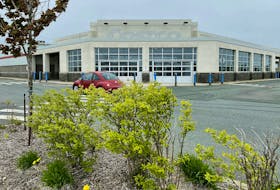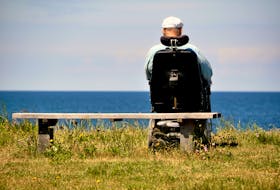
The 16 soldiers, members of the Station Defence Force, sprang into action.
Running out into the parking lot with what first aid kits they could grab, they encountered a badly damaged car, flames and smoke, loud sirens, and spilled blood, and bloodied and screaming casualties lying around outside of and within the car wreckage.
It was a training drill, of course, but the gory realism upped the level of confusion, urgency and stress the soldiers felt.
And that is the main point of such a training scenario said Master Cpl. Garrett McDougall of 35 Field Ambulance Unit.
“The big thing for us here is realism. Rarely do we get the opportunity to have these sort of scenarios where we are going to have smoke, the car there, lots of makeup,” he said.

“Realism really adds to this scenario, particularly for medical scenarios. The issue you run into a lot of the time with the lack of realism is that people become complacent with the scenario. So it does two things: it helps to make the situation more realistic and it gets people’s hearts pumping, makes them worry, makes them freak out a little bit so they are going to have to learn how they are going to deal with that stress response.”
Exercises such as these provide regular members of the Canadian Armed Forces and Reserve units the opportunity to practice and further develop their skills in a controlled learning environment.
Whether training in smaller numbers at various stations and bases around the country, or in greater numbers on the national and international stage alongside allied forces, soldiers are constantly training to be combat ready for a wide spectrum of operations and emergency situations.
On Thursday, six members of the 35 Field Ambulance Unit donned makeup and other special-effects items to resemble serious injuries that could result should a car bomb explode with mass casualties.

Injuries included everything from an amputated leg, facial shrapnel wounds and burns, broken arms, a severed hand, concussions and one apparent fatality. The narrative for the scenario included instructions to each actor to aggressively play the part that matched their particular injuries, from loud cries and screams of pain, to wandering in confusion around the scene, and looking for their comrades while getting in the way of responders.
The actors spent hours getting ready before the exercise and created real-looking injuries with makeup from methods they learned on their own. There is, however, a week-long course the military offers to train soldiers in the use of makeup for use in realism-type scenarios.
“They don’t teach us acting, though,” quipped Pte. Matt Mackenzie.

After the exercise ended, members of the Station Defence Force, actors and monitors of the exercise went back to the classroom to review what was done right, what may have been done wrong, and what can be improved upon.
CPO1 Lee Brown, Base Chief Petty Officer for CFB Halifax who attended the exercise, reminded the soldiers that real life situations could arise when least expected and when you may have little or no first-aid supplies on hand.
“You would have to improvise, use what’s around you to apply first aid,” he said. “Our job is to carry on, do what you can do.”
Discussed in the classroom were also issues of securing the scene in case another bomb or secondary threat was present, how the various wounds were identified and treated, and how casualties were moved to a collection point.
Brown said it was also important to utilize the expertise of the top medic at the scene, even if that person is of lower rank.
“In a situation like that, rank doesn’t matter, it is the (medic’s) expertise in dealing with these medical sort of issues,” Brown said. “I’d be looking to you as to what do you want us to do next, where do you need us to be. Don’t be afraid that if there are senior ranks there, don’t be afraid to detail them off to help you out.”
Anyone walking the trail around Quidi Vidi Lake or driving by the base in Pleasantville Thursday morning may have been wondering what was going on.
CFS St. John’s Commanding Officer Lt.-Cmdr. Gerry Parsons said the public in general needs to be aware of the type of training and combat-preparedness work taking place at the base.
“We take this stuff seriously,” he said. “Training exercises like this prepare you, and we’ve had a lot of good feedback and points made by the team.”
Parsons pointed out how important it is for various military units to work together, and also to work with police and other groups in the community.
He noted, for instance, there have been training scenarios in the past involving the Royal Newfoundland Constabulary’s IED (improvised explosive device) Unit and SWAT team.
Parsons said such training helps prepare for real life events that can and do take place at bases across the country.
“We’ve had real threats. All these things we think can’t happen in a Canadian Forces Base happen,” Parsons noted. “We’ve had people trying to gain access to this building a couple years ago. This is real, vigilance is the message. The public needs to know about it. The biggest thing that makes me proud is that we are training as we fight.”
Many of the soldiers admitted to feelings of being overwhelmed and stressed during the exercise, and that the scene they encountered was realistic. The soldiers also said such training exercises are a boost to recruitment efforts.
“This is great for recruitment for the very reason it shows you what you can get in the military that you can’t get elsewhere,” McDougall said. “It’s that high-paced, high-intensity training, doing all kinds of really cool, very exciting stuff that’s just not readily available elsewhere.
“So training like this does two things: It works great to build up the effectiveness in combat readiness of our guys and it really draws the public eye to us. It puts some attention to us and shows what we can really do here with the Reserves. What we can offer.”








